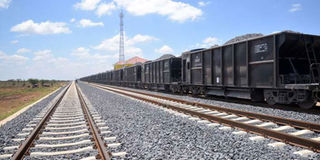KISERO: Let us rethink national interest strategy in regional integration

A section of the Standard Gauge Railway crossing Makueni County on March 17, 2016. SGR will be completed next year. PHOTO | SALATON NJAU | NATION MEDIA GROUP
What you need to know:
- If Uganda also comes up to argue that SGR does not make economic sense to them, we will end up with a bridge to nowhere.
- Kenya did not do a good job of configuring its relations with its neighbours around well-defined national interest strategies.
- We need to refine our national interest strategy more sharply when it comes to regional infrastructure projects.
- We need to take a fresh look at the SGR and discuss its economic viability.
Coming hardly a month after Uganda decided to route its oil pipeline through Tanzanian instead of Kenya, the decision by Rwanda to develop a railway link through Dar es Salaam port instead of Mombasa makes it look as if our partners in the East African Community are ganging up against us.
But is Kigali’s action likely to affect the viability of our own standard gauge railway (SGR) project? This is a pertinent question because we are at a very advanced stage with our side of the SGR, the segment between Mombasa and Nairobi projected to be ready in a matter of months.
Just the other day, we signed a massive $1.5 billion loan with the Chinese to build the extension from Nairobi to Naivasha. We are in the advanced stages of securing a $4.8 billion loan from Exim Bank of China to extend the line to Malaba through Kisumu. Mark you, the economic viability of these plans were premised on the assumption that the SGR would extend to Kigali.
And it is not as if Kigali has suddenly discovered that a link through Dar es Salaam is cheaper and shorter than Mombasa. Kigali was part of the decision by the 11th summit of the Northern Corridor Integration Project of October last year that agreed that Naivasha-Kisumu-Malaba was a vital link to the proposed line to Kampala and Kigali. It is this summit that gave Kenya the go-ahead to fast-track negotiating Chinese financing for the Kisumu to Malaba line.
POLITICAL SOLIDARITY
If Uganda also comes up to argue that SGR does not make economic sense to them, we will end up with a bridge to nowhere.
National interest precedes political solidarity and ordinary diplomatic relations between states. Perhaps because we are the dominant economy in the region — and considering that cooperation between East African partner states was structured around the principle of asymmetry, where the bigger brother must make concessions to his smaller siblings — Kenya did not do a good job of configuring its relations with its neighbours around well-defined national interest strategies.
Yet, truth be told, Kigali’s move is not a very big deal, especially when put in the context of the scope of the SGR. In terms of the volumes of traded goods on the Northern Corridor, Rwanda represents only 8 per cent compared to 39 per cent for Uganda. Indeed, traffic along the corridor falls off rapidly as it moves away from Mombasa.
Secondly, the Rwanda segment of our SGR covers a short distance of about 177 kilometres between Mirama Hills in Western Uganda and Kigali. This is against 1,915 kilometres for the SGR as originally planned.
The lesson here is that we need to refine our national interest strategy more sharply when it comes to regional infrastructure projects. Clearly, our long-term interest remains in pumping money in developing new transport corridors between us and Ethiopia, South Sudan, even Somalia.
ECONOMIC VIABILITY
We need to take a fresh look at the SGR and discuss its economic viability. Last year, the ministers of Finance for Kenya, Uganda, and Rwanda mandated a group of consultants, operating under the brand Africa 50, to develop a business plan for the SGR.
That study has raised serious doubts about the viability of the project when it comes to parameters such as rate of return, projected traffic volumes, and financial sustainability. And we have borrowed too much money from China for this single project.
The way I see it, what is going to tip the scales for us in these endless cloak-and-dagger games for regional dominance with our neighbours is Mombasa, the largest port in the region. Only recently, we completed building a state-of-the art container terminal to double the capacity of the port and allow access to vessels twice as large as those currently calling at the port.
Indeed, this new facility is how we wanted to reposition Mombasa as the reference port along the Indian Ocean coast, making it possible for the port to out-compete Djibouti, Dar es Salaam, and Maputo.
Our ambition was to have a high-performance port that connects to the standard gauge railway to form a fully integrated transportation chain and corridor running all the way to Kigali.
Who was to manage the facility? We decided to experiment with an experienced private international port operator working at very high standards of efficiency.
However, tenderpreneurs scuttled everything, the upshot of which was that we have now handed the facility to the Kenya Ports Authority.
This is equivalent to allowing a jua kali garage to service and maintain your new Bentley. Lack of strategic foresight.





